Unfavorable in Hospital Events: A Systematic Review 2022
VerifiedAdded on 2022/09/25
|9
|2186
|15
AI Summary
Contribute Materials
Your contribution can guide someone’s learning journey. Share your
documents today.
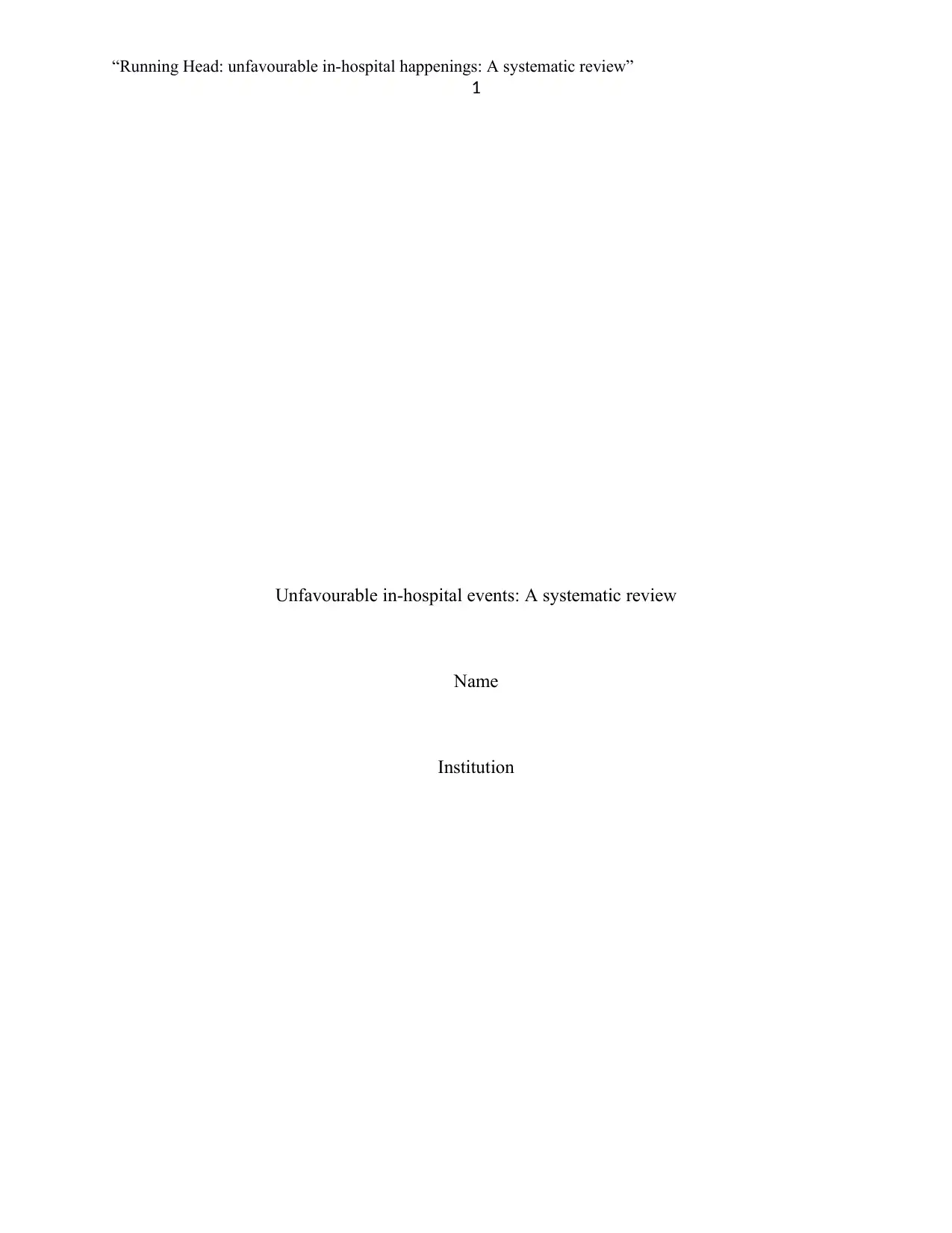
“Running Head: unfavourable in-hospital happenings: A systematic review”
1
Unfavourable in-hospital events: A systematic review
Name
Institution
1
Unfavourable in-hospital events: A systematic review
Name
Institution
Secure Best Marks with AI Grader
Need help grading? Try our AI Grader for instant feedback on your assignments.
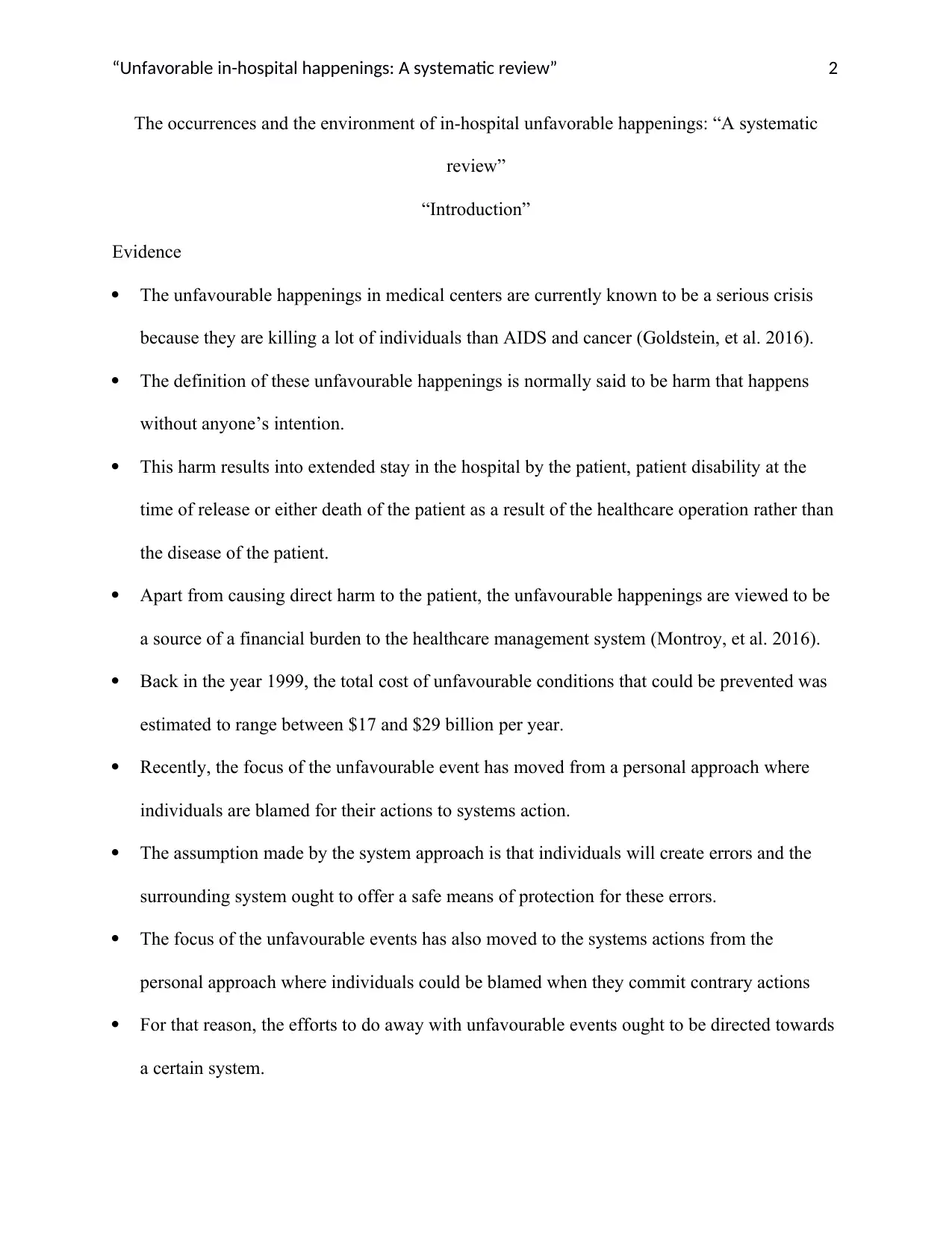
“Unfavorable in-hospital happenings: A systematic review” 2
The occurrences and the environment of in-hospital unfavorable happenings: “A systematic
review”
“Introduction”
Evidence
The unfavourable happenings in medical centers are currently known to be a serious crisis
because they are killing a lot of individuals than AIDS and cancer (Goldstein, et al. 2016).
The definition of these unfavourable happenings is normally said to be harm that happens
without anyone’s intention.
This harm results into extended stay in the hospital by the patient, patient disability at the
time of release or either death of the patient as a result of the healthcare operation rather than
the disease of the patient.
Apart from causing direct harm to the patient, the unfavourable happenings are viewed to be
a source of a financial burden to the healthcare management system (Montroy, et al. 2016).
Back in the year 1999, the total cost of unfavourable conditions that could be prevented was
estimated to range between $17 and $29 billion per year.
Recently, the focus of the unfavourable event has moved from a personal approach where
individuals are blamed for their actions to systems action.
The assumption made by the system approach is that individuals will create errors and the
surrounding system ought to offer a safe means of protection for these errors.
The focus of the unfavourable events has also moved to the systems actions from the
personal approach where individuals could be blamed when they commit contrary actions
For that reason, the efforts to do away with unfavourable events ought to be directed towards
a certain system.
The occurrences and the environment of in-hospital unfavorable happenings: “A systematic
review”
“Introduction”
Evidence
The unfavourable happenings in medical centers are currently known to be a serious crisis
because they are killing a lot of individuals than AIDS and cancer (Goldstein, et al. 2016).
The definition of these unfavourable happenings is normally said to be harm that happens
without anyone’s intention.
This harm results into extended stay in the hospital by the patient, patient disability at the
time of release or either death of the patient as a result of the healthcare operation rather than
the disease of the patient.
Apart from causing direct harm to the patient, the unfavourable happenings are viewed to be
a source of a financial burden to the healthcare management system (Montroy, et al. 2016).
Back in the year 1999, the total cost of unfavourable conditions that could be prevented was
estimated to range between $17 and $29 billion per year.
Recently, the focus of the unfavourable event has moved from a personal approach where
individuals are blamed for their actions to systems action.
The assumption made by the system approach is that individuals will create errors and the
surrounding system ought to offer a safe means of protection for these errors.
The focus of the unfavourable events has also moved to the systems actions from the
personal approach where individuals could be blamed when they commit contrary actions
For that reason, the efforts to do away with unfavourable events ought to be directed towards
a certain system.
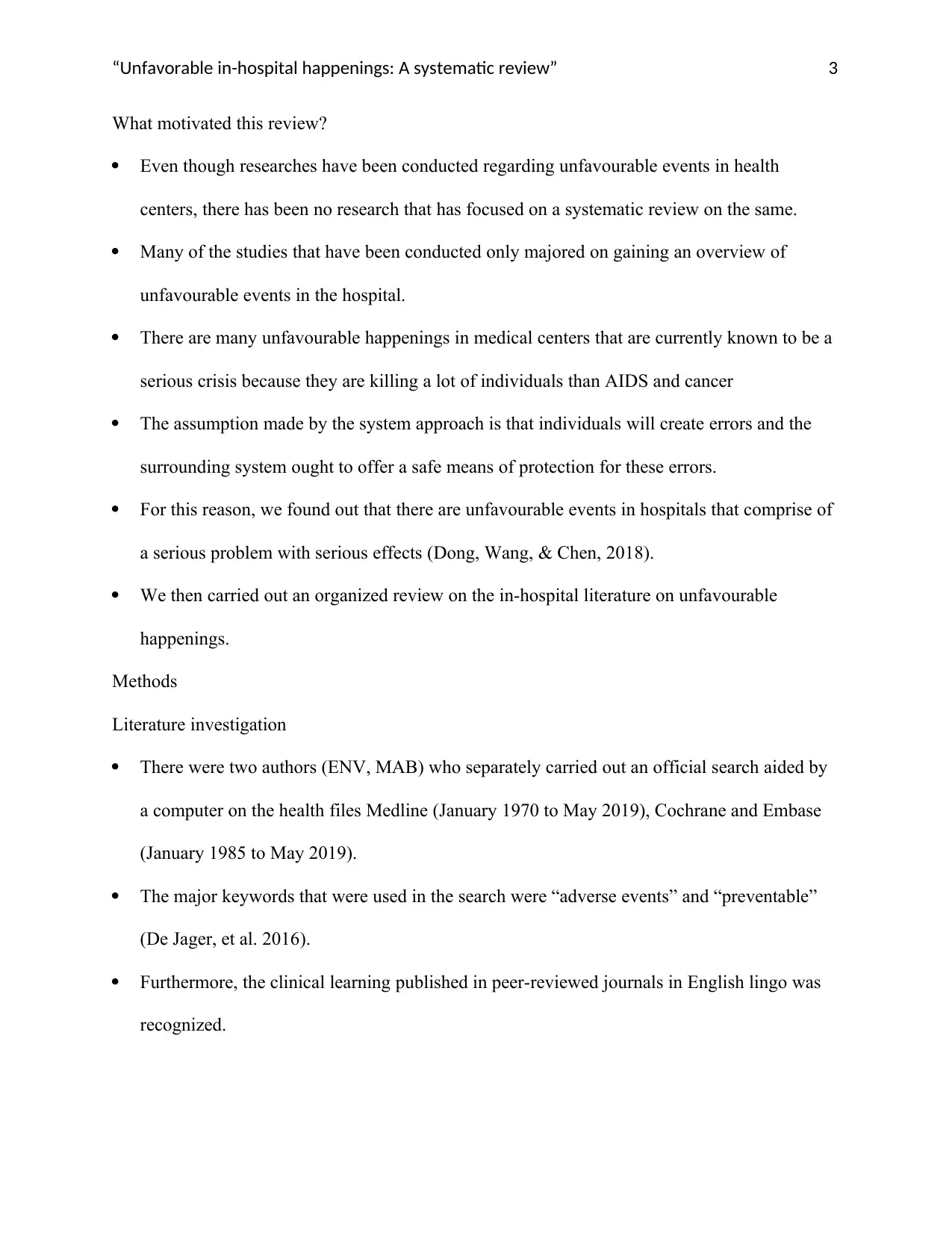
“Unfavorable in-hospital happenings: A systematic review” 3
What motivated this review?
Even though researches have been conducted regarding unfavourable events in health
centers, there has been no research that has focused on a systematic review on the same.
Many of the studies that have been conducted only majored on gaining an overview of
unfavourable events in the hospital.
There are many unfavourable happenings in medical centers that are currently known to be a
serious crisis because they are killing a lot of individuals than AIDS and cancer
The assumption made by the system approach is that individuals will create errors and the
surrounding system ought to offer a safe means of protection for these errors.
For this reason, we found out that there are unfavourable events in hospitals that comprise of
a serious problem with serious effects (Dong, Wang, & Chen, 2018).
We then carried out an organized review on the in-hospital literature on unfavourable
happenings.
Methods
Literature investigation
There were two authors (ENV, MAB) who separately carried out an official search aided by
a computer on the health files Medline (January 1970 to May 2019), Cochrane and Embase
(January 1985 to May 2019).
The major keywords that were used in the search were “adverse events” and “preventable”
(De Jager, et al. 2016).
Furthermore, the clinical learning published in peer-reviewed journals in English lingo was
recognized.
What motivated this review?
Even though researches have been conducted regarding unfavourable events in health
centers, there has been no research that has focused on a systematic review on the same.
Many of the studies that have been conducted only majored on gaining an overview of
unfavourable events in the hospital.
There are many unfavourable happenings in medical centers that are currently known to be a
serious crisis because they are killing a lot of individuals than AIDS and cancer
The assumption made by the system approach is that individuals will create errors and the
surrounding system ought to offer a safe means of protection for these errors.
For this reason, we found out that there are unfavourable events in hospitals that comprise of
a serious problem with serious effects (Dong, Wang, & Chen, 2018).
We then carried out an organized review on the in-hospital literature on unfavourable
happenings.
Methods
Literature investigation
There were two authors (ENV, MAB) who separately carried out an official search aided by
a computer on the health files Medline (January 1970 to May 2019), Cochrane and Embase
(January 1985 to May 2019).
The major keywords that were used in the search were “adverse events” and “preventable”
(De Jager, et al. 2016).
Furthermore, the clinical learning published in peer-reviewed journals in English lingo was
recognized.
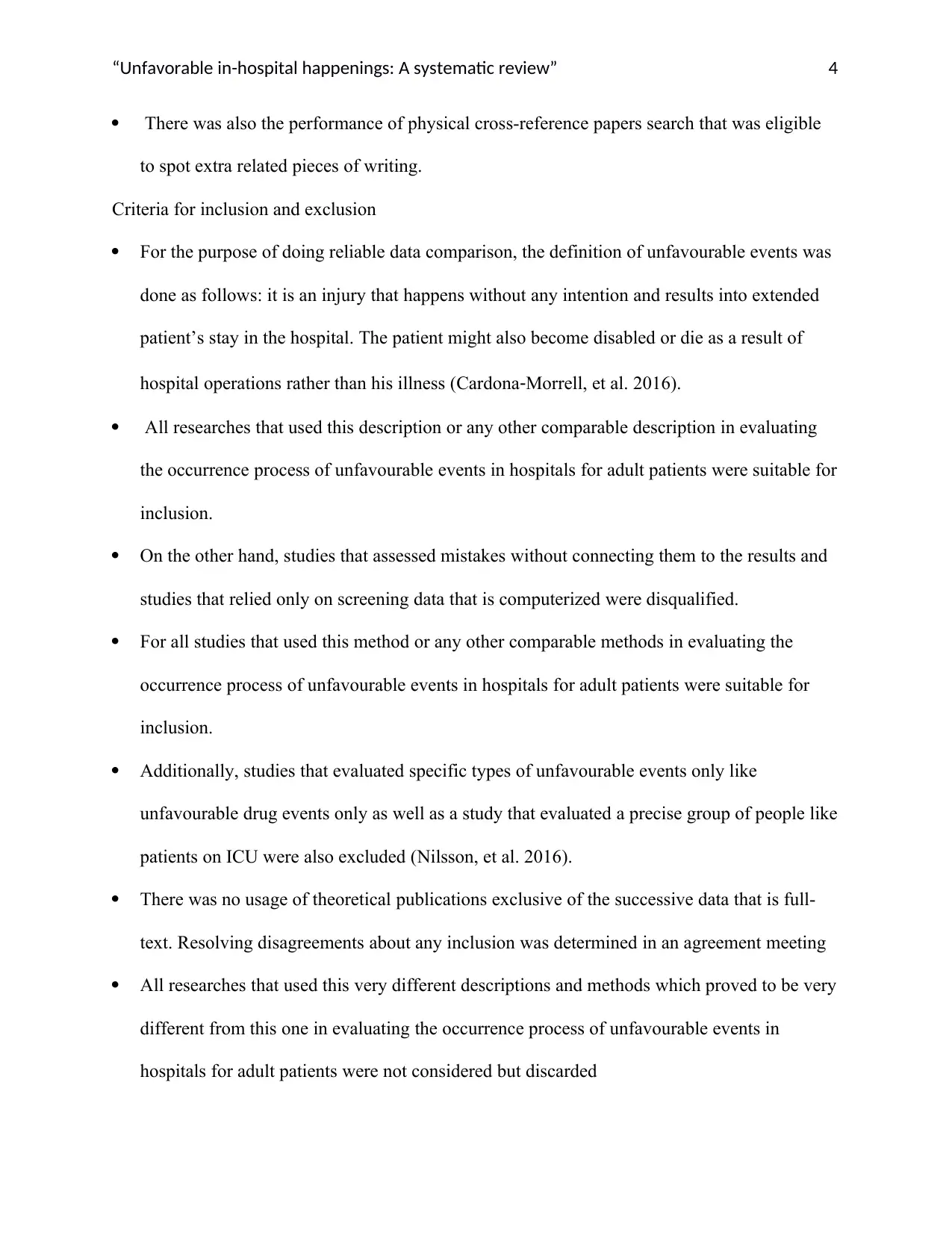
“Unfavorable in-hospital happenings: A systematic review” 4
There was also the performance of physical cross-reference papers search that was eligible
to spot extra related pieces of writing.
Criteria for inclusion and exclusion
For the purpose of doing reliable data comparison, the definition of unfavourable events was
done as follows: it is an injury that happens without any intention and results into extended
patient’s stay in the hospital. The patient might also become disabled or die as a result of
hospital operations rather than his illness (Cardona‐Morrell, et al. 2016).
All researches that used this description or any other comparable description in evaluating
the occurrence process of unfavourable events in hospitals for adult patients were suitable for
inclusion.
On the other hand, studies that assessed mistakes without connecting them to the results and
studies that relied only on screening data that is computerized were disqualified.
For all studies that used this method or any other comparable methods in evaluating the
occurrence process of unfavourable events in hospitals for adult patients were suitable for
inclusion.
Additionally, studies that evaluated specific types of unfavourable events only like
unfavourable drug events only as well as a study that evaluated a precise group of people like
patients on ICU were also excluded (Nilsson, et al. 2016).
There was no usage of theoretical publications exclusive of the successive data that is full-
text. Resolving disagreements about any inclusion was determined in an agreement meeting
All researches that used this very different descriptions and methods which proved to be very
different from this one in evaluating the occurrence process of unfavourable events in
hospitals for adult patients were not considered but discarded
There was also the performance of physical cross-reference papers search that was eligible
to spot extra related pieces of writing.
Criteria for inclusion and exclusion
For the purpose of doing reliable data comparison, the definition of unfavourable events was
done as follows: it is an injury that happens without any intention and results into extended
patient’s stay in the hospital. The patient might also become disabled or die as a result of
hospital operations rather than his illness (Cardona‐Morrell, et al. 2016).
All researches that used this description or any other comparable description in evaluating
the occurrence process of unfavourable events in hospitals for adult patients were suitable for
inclusion.
On the other hand, studies that assessed mistakes without connecting them to the results and
studies that relied only on screening data that is computerized were disqualified.
For all studies that used this method or any other comparable methods in evaluating the
occurrence process of unfavourable events in hospitals for adult patients were suitable for
inclusion.
Additionally, studies that evaluated specific types of unfavourable events only like
unfavourable drug events only as well as a study that evaluated a precise group of people like
patients on ICU were also excluded (Nilsson, et al. 2016).
There was no usage of theoretical publications exclusive of the successive data that is full-
text. Resolving disagreements about any inclusion was determined in an agreement meeting
All researches that used this very different descriptions and methods which proved to be very
different from this one in evaluating the occurrence process of unfavourable events in
hospitals for adult patients were not considered but discarded
Secure Best Marks with AI Grader
Need help grading? Try our AI Grader for instant feedback on your assignments.
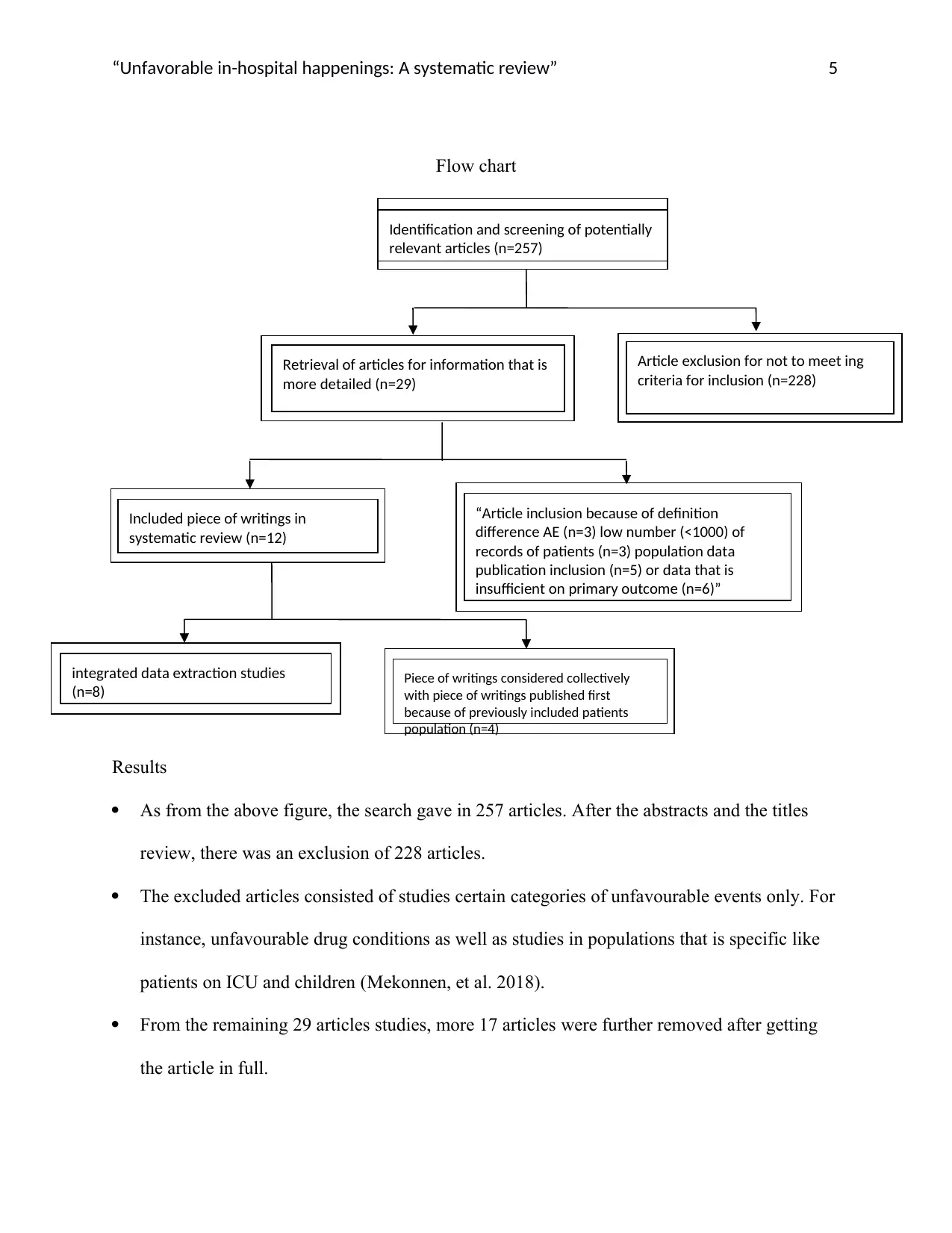
“Unfavorable in-hospital happenings: A systematic review” 5
Flow chart
Results
As from the above figure, the search gave in 257 articles. After the abstracts and the titles
review, there was an exclusion of 228 articles.
The excluded articles consisted of studies certain categories of unfavourable events only. For
instance, unfavourable drug conditions as well as studies in populations that is specific like
patients on ICU and children (Mekonnen, et al. 2018).
From the remaining 29 articles studies, more 17 articles were further removed after getting
the article in full.
Identification and screening of potentially
relevant articles (n=257)
Retrieval of articles for information that is
more detailed (n=29)
Article exclusion for not to meet ing
criteria for inclusion (n=228)
Included piece of writings in
systematic review (n=12)
“Article inclusion because of definition
difference AE (n=3) low number (<1000) of
records of patients (n=3) population data
publication inclusion (n=5) or data that is
insufficient on primary outcome (n=6)”
integrated data extraction studies
(n=8) Piece of writings considered collectively
with piece of writings published first
because of previously included patients
population (n=4)
Flow chart
Results
As from the above figure, the search gave in 257 articles. After the abstracts and the titles
review, there was an exclusion of 228 articles.
The excluded articles consisted of studies certain categories of unfavourable events only. For
instance, unfavourable drug conditions as well as studies in populations that is specific like
patients on ICU and children (Mekonnen, et al. 2018).
From the remaining 29 articles studies, more 17 articles were further removed after getting
the article in full.
Identification and screening of potentially
relevant articles (n=257)
Retrieval of articles for information that is
more detailed (n=29)
Article exclusion for not to meet ing
criteria for inclusion (n=228)
Included piece of writings in
systematic review (n=12)
“Article inclusion because of definition
difference AE (n=3) low number (<1000) of
records of patients (n=3) population data
publication inclusion (n=5) or data that is
insufficient on primary outcome (n=6)”
integrated data extraction studies
(n=8) Piece of writings considered collectively
with piece of writings published first
because of previously included patients
population (n=4)
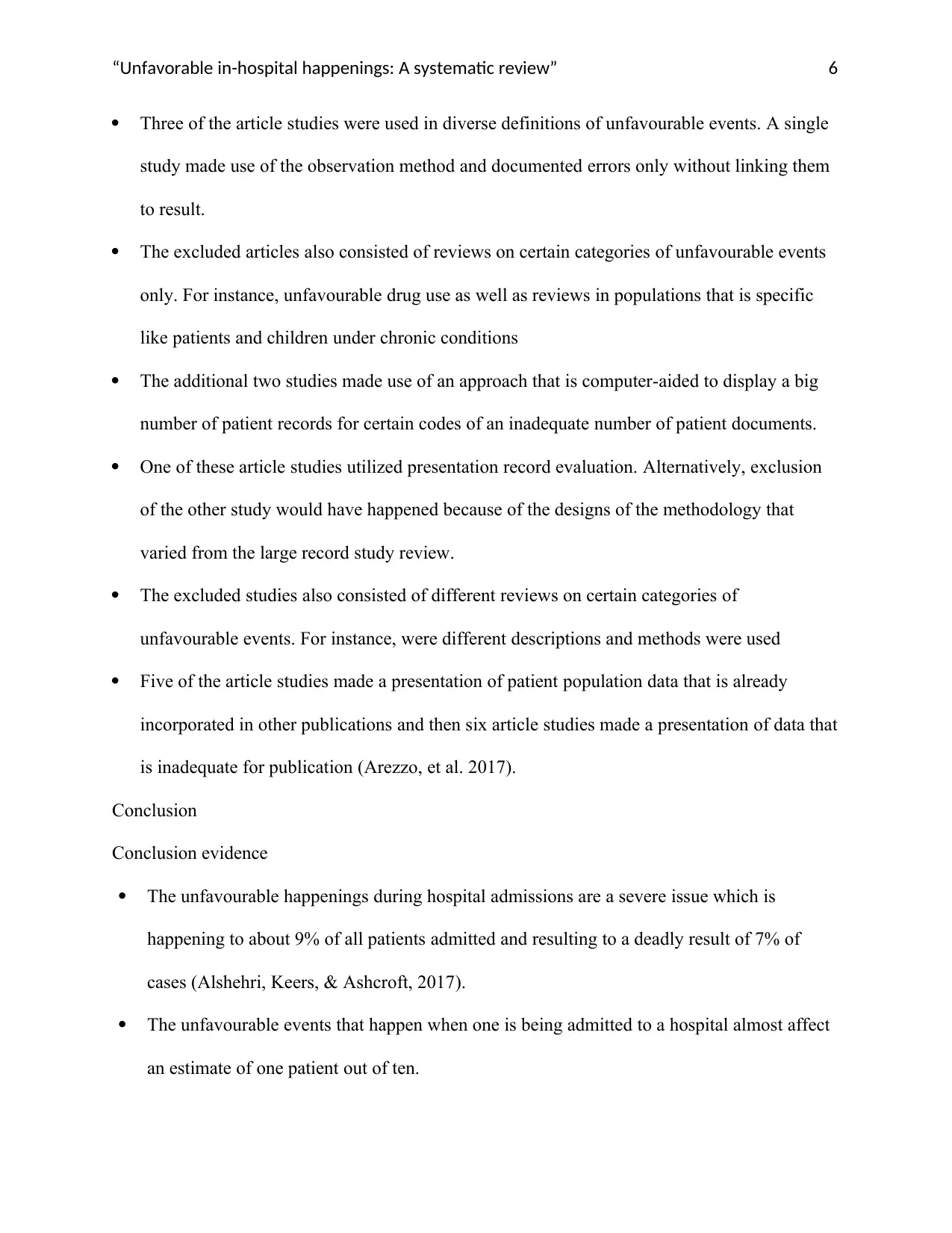
“Unfavorable in-hospital happenings: A systematic review” 6
Three of the article studies were used in diverse definitions of unfavourable events. A single
study made use of the observation method and documented errors only without linking them
to result.
The excluded articles also consisted of reviews on certain categories of unfavourable events
only. For instance, unfavourable drug use as well as reviews in populations that is specific
like patients and children under chronic conditions
The additional two studies made use of an approach that is computer-aided to display a big
number of patient records for certain codes of an inadequate number of patient documents.
One of these article studies utilized presentation record evaluation. Alternatively, exclusion
of the other study would have happened because of the designs of the methodology that
varied from the large record study review.
The excluded studies also consisted of different reviews on certain categories of
unfavourable events. For instance, were different descriptions and methods were used
Five of the article studies made a presentation of patient population data that is already
incorporated in other publications and then six article studies made a presentation of data that
is inadequate for publication (Arezzo, et al. 2017).
Conclusion
Conclusion evidence
The unfavourable happenings during hospital admissions are a severe issue which is
happening to about 9% of all patients admitted and resulting to a deadly result of 7% of
cases (Alshehri, Keers, & Ashcroft, 2017).
The unfavourable events that happen when one is being admitted to a hospital almost affect
an estimate of one patient out of ten.
Three of the article studies were used in diverse definitions of unfavourable events. A single
study made use of the observation method and documented errors only without linking them
to result.
The excluded articles also consisted of reviews on certain categories of unfavourable events
only. For instance, unfavourable drug use as well as reviews in populations that is specific
like patients and children under chronic conditions
The additional two studies made use of an approach that is computer-aided to display a big
number of patient records for certain codes of an inadequate number of patient documents.
One of these article studies utilized presentation record evaluation. Alternatively, exclusion
of the other study would have happened because of the designs of the methodology that
varied from the large record study review.
The excluded studies also consisted of different reviews on certain categories of
unfavourable events. For instance, were different descriptions and methods were used
Five of the article studies made a presentation of patient population data that is already
incorporated in other publications and then six article studies made a presentation of data that
is inadequate for publication (Arezzo, et al. 2017).
Conclusion
Conclusion evidence
The unfavourable happenings during hospital admissions are a severe issue which is
happening to about 9% of all patients admitted and resulting to a deadly result of 7% of
cases (Alshehri, Keers, & Ashcroft, 2017).
The unfavourable events that happen when one is being admitted to a hospital almost affect
an estimate of one patient out of ten.
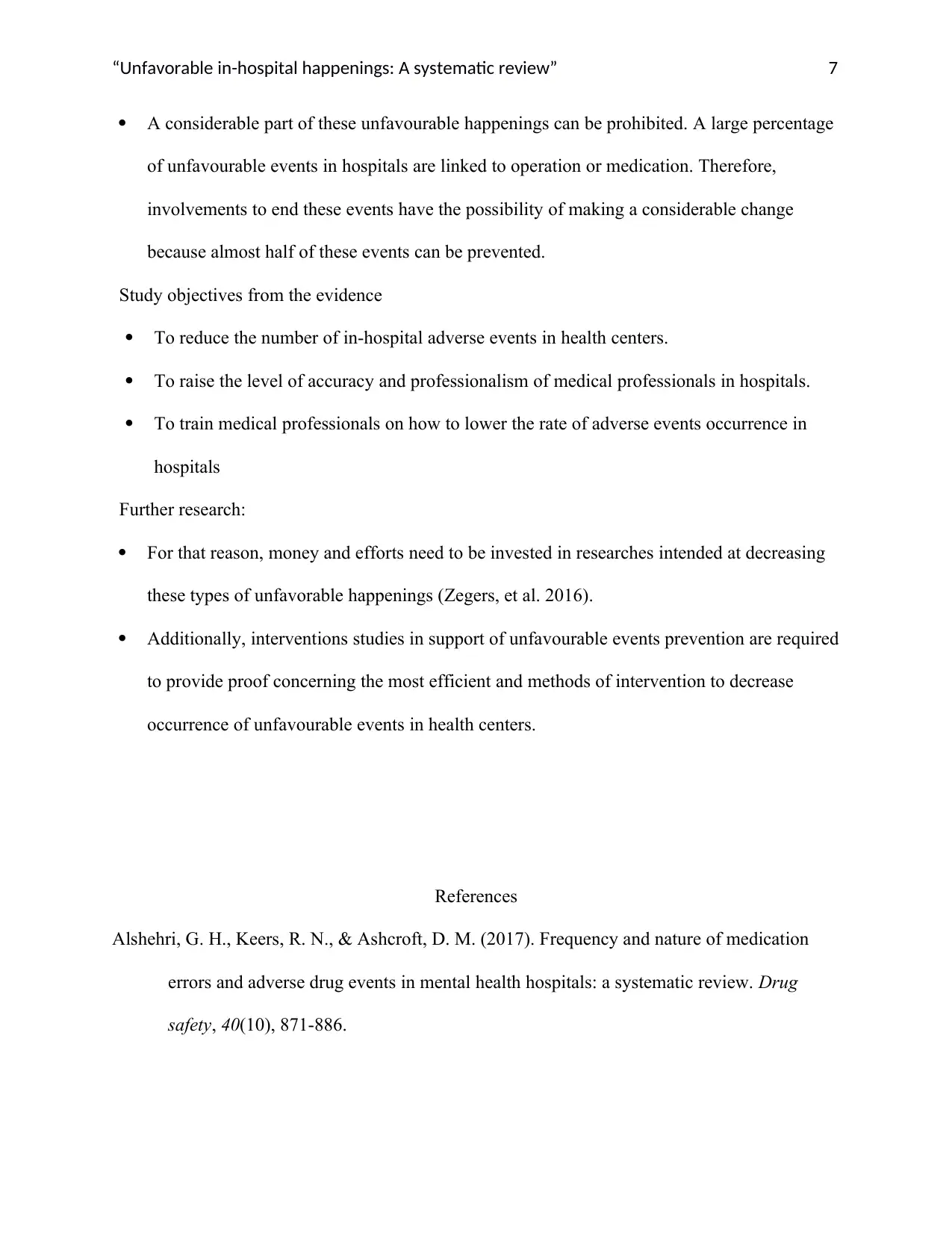
“Unfavorable in-hospital happenings: A systematic review” 7
A considerable part of these unfavourable happenings can be prohibited. A large percentage
of unfavourable events in hospitals are linked to operation or medication. Therefore,
involvements to end these events have the possibility of making a considerable change
because almost half of these events can be prevented.
Study objectives from the evidence
To reduce the number of in-hospital adverse events in health centers.
To raise the level of accuracy and professionalism of medical professionals in hospitals.
To train medical professionals on how to lower the rate of adverse events occurrence in
hospitals
Further research:
For that reason, money and efforts need to be invested in researches intended at decreasing
these types of unfavorable happenings (Zegers, et al. 2016).
Additionally, interventions studies in support of unfavourable events prevention are required
to provide proof concerning the most efficient and methods of intervention to decrease
occurrence of unfavourable events in health centers.
References
Alshehri, G. H., Keers, R. N., & Ashcroft, D. M. (2017). Frequency and nature of medication
errors and adverse drug events in mental health hospitals: a systematic review. Drug
safety, 40(10), 871-886.
A considerable part of these unfavourable happenings can be prohibited. A large percentage
of unfavourable events in hospitals are linked to operation or medication. Therefore,
involvements to end these events have the possibility of making a considerable change
because almost half of these events can be prevented.
Study objectives from the evidence
To reduce the number of in-hospital adverse events in health centers.
To raise the level of accuracy and professionalism of medical professionals in hospitals.
To train medical professionals on how to lower the rate of adverse events occurrence in
hospitals
Further research:
For that reason, money and efforts need to be invested in researches intended at decreasing
these types of unfavorable happenings (Zegers, et al. 2016).
Additionally, interventions studies in support of unfavourable events prevention are required
to provide proof concerning the most efficient and methods of intervention to decrease
occurrence of unfavourable events in health centers.
References
Alshehri, G. H., Keers, R. N., & Ashcroft, D. M. (2017). Frequency and nature of medication
errors and adverse drug events in mental health hospitals: a systematic review. Drug
safety, 40(10), 871-886.
Paraphrase This Document
Need a fresh take? Get an instant paraphrase of this document with our AI Paraphraser
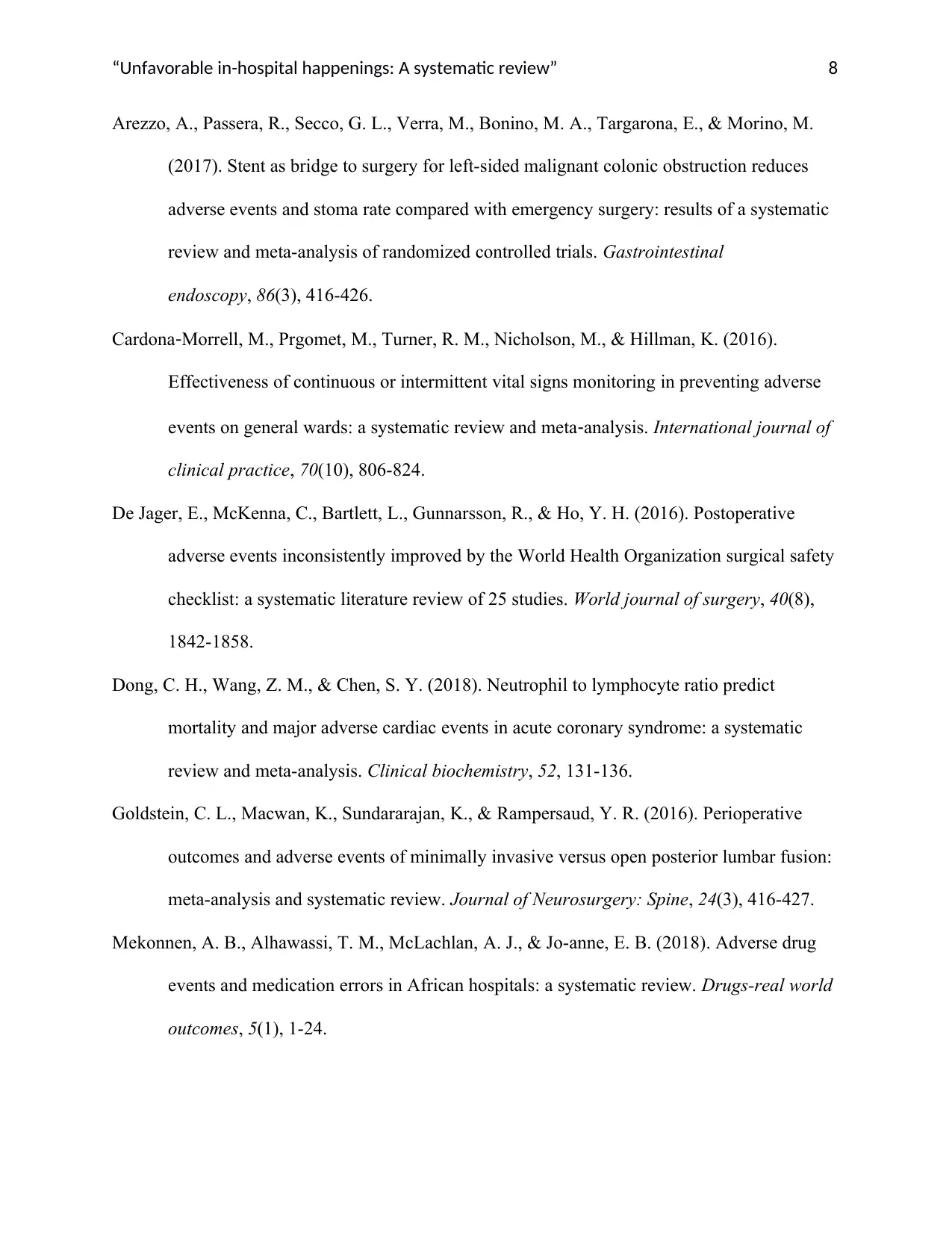
“Unfavorable in-hospital happenings: A systematic review” 8
Arezzo, A., Passera, R., Secco, G. L., Verra, M., Bonino, M. A., Targarona, E., & Morino, M.
(2017). Stent as bridge to surgery for left-sided malignant colonic obstruction reduces
adverse events and stoma rate compared with emergency surgery: results of a systematic
review and meta-analysis of randomized controlled trials. Gastrointestinal
endoscopy, 86(3), 416-426.
Cardona‐Morrell, M., Prgomet, M., Turner, R. M., Nicholson, M., & Hillman, K. (2016).
Effectiveness of continuous or intermittent vital signs monitoring in preventing adverse
events on general wards: a systematic review and meta‐analysis. International journal of
clinical practice, 70(10), 806-824.
De Jager, E., McKenna, C., Bartlett, L., Gunnarsson, R., & Ho, Y. H. (2016). Postoperative
adverse events inconsistently improved by the World Health Organization surgical safety
checklist: a systematic literature review of 25 studies. World journal of surgery, 40(8),
1842-1858.
Dong, C. H., Wang, Z. M., & Chen, S. Y. (2018). Neutrophil to lymphocyte ratio predict
mortality and major adverse cardiac events in acute coronary syndrome: a systematic
review and meta-analysis. Clinical biochemistry, 52, 131-136.
Goldstein, C. L., Macwan, K., Sundararajan, K., & Rampersaud, Y. R. (2016). Perioperative
outcomes and adverse events of minimally invasive versus open posterior lumbar fusion:
meta-analysis and systematic review. Journal of Neurosurgery: Spine, 24(3), 416-427.
Mekonnen, A. B., Alhawassi, T. M., McLachlan, A. J., & Jo-anne, E. B. (2018). Adverse drug
events and medication errors in African hospitals: a systematic review. Drugs-real world
outcomes, 5(1), 1-24.
Arezzo, A., Passera, R., Secco, G. L., Verra, M., Bonino, M. A., Targarona, E., & Morino, M.
(2017). Stent as bridge to surgery for left-sided malignant colonic obstruction reduces
adverse events and stoma rate compared with emergency surgery: results of a systematic
review and meta-analysis of randomized controlled trials. Gastrointestinal
endoscopy, 86(3), 416-426.
Cardona‐Morrell, M., Prgomet, M., Turner, R. M., Nicholson, M., & Hillman, K. (2016).
Effectiveness of continuous or intermittent vital signs monitoring in preventing adverse
events on general wards: a systematic review and meta‐analysis. International journal of
clinical practice, 70(10), 806-824.
De Jager, E., McKenna, C., Bartlett, L., Gunnarsson, R., & Ho, Y. H. (2016). Postoperative
adverse events inconsistently improved by the World Health Organization surgical safety
checklist: a systematic literature review of 25 studies. World journal of surgery, 40(8),
1842-1858.
Dong, C. H., Wang, Z. M., & Chen, S. Y. (2018). Neutrophil to lymphocyte ratio predict
mortality and major adverse cardiac events in acute coronary syndrome: a systematic
review and meta-analysis. Clinical biochemistry, 52, 131-136.
Goldstein, C. L., Macwan, K., Sundararajan, K., & Rampersaud, Y. R. (2016). Perioperative
outcomes and adverse events of minimally invasive versus open posterior lumbar fusion:
meta-analysis and systematic review. Journal of Neurosurgery: Spine, 24(3), 416-427.
Mekonnen, A. B., Alhawassi, T. M., McLachlan, A. J., & Jo-anne, E. B. (2018). Adverse drug
events and medication errors in African hospitals: a systematic review. Drugs-real world
outcomes, 5(1), 1-24.
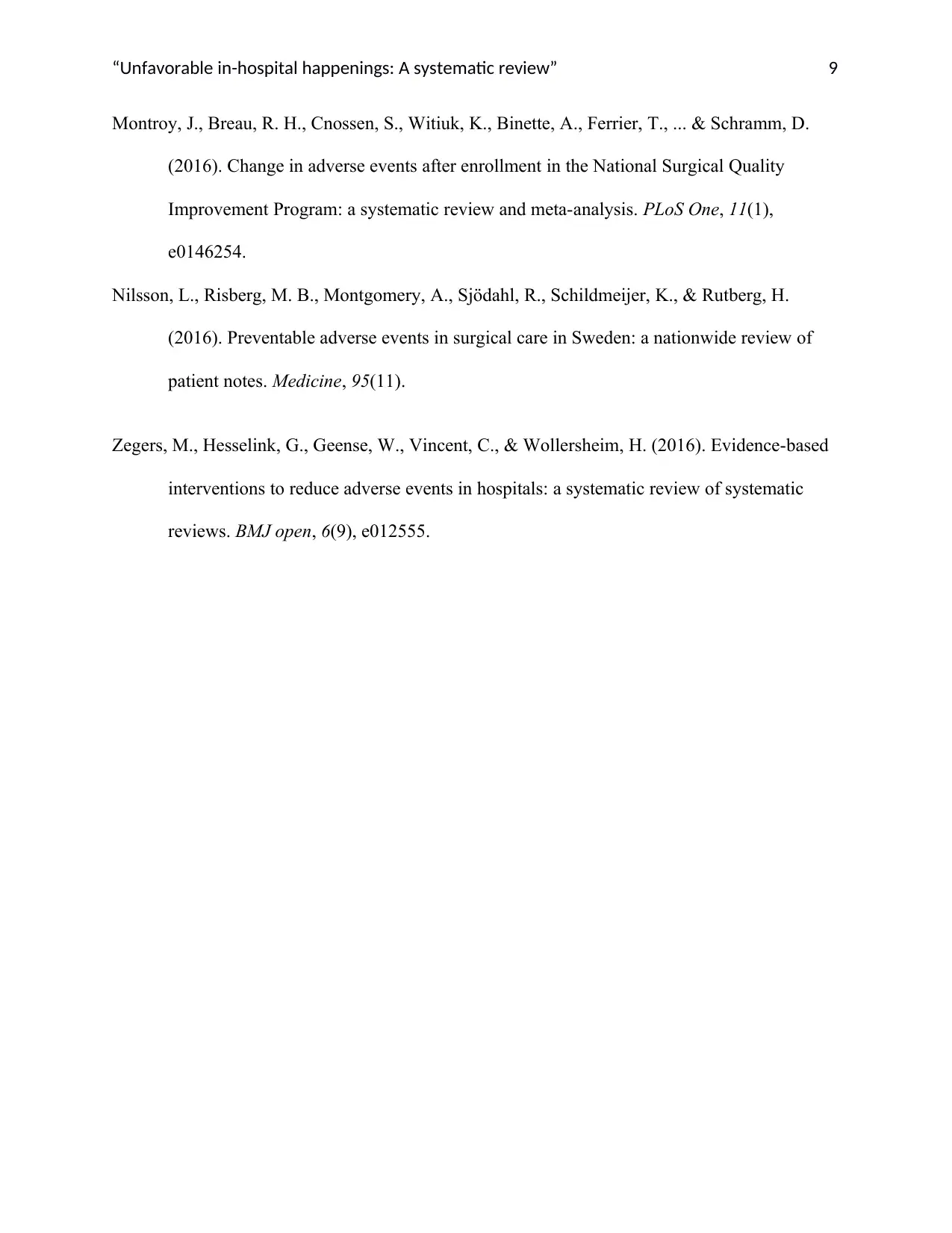
“Unfavorable in-hospital happenings: A systematic review” 9
Montroy, J., Breau, R. H., Cnossen, S., Witiuk, K., Binette, A., Ferrier, T., ... & Schramm, D.
(2016). Change in adverse events after enrollment in the National Surgical Quality
Improvement Program: a systematic review and meta-analysis. PLoS One, 11(1),
e0146254.
Nilsson, L., Risberg, M. B., Montgomery, A., Sjödahl, R., Schildmeijer, K., & Rutberg, H.
(2016). Preventable adverse events in surgical care in Sweden: a nationwide review of
patient notes. Medicine, 95(11).
Zegers, M., Hesselink, G., Geense, W., Vincent, C., & Wollersheim, H. (2016). Evidence-based
interventions to reduce adverse events in hospitals: a systematic review of systematic
reviews. BMJ open, 6(9), e012555.
Montroy, J., Breau, R. H., Cnossen, S., Witiuk, K., Binette, A., Ferrier, T., ... & Schramm, D.
(2016). Change in adverse events after enrollment in the National Surgical Quality
Improvement Program: a systematic review and meta-analysis. PLoS One, 11(1),
e0146254.
Nilsson, L., Risberg, M. B., Montgomery, A., Sjödahl, R., Schildmeijer, K., & Rutberg, H.
(2016). Preventable adverse events in surgical care in Sweden: a nationwide review of
patient notes. Medicine, 95(11).
Zegers, M., Hesselink, G., Geense, W., Vincent, C., & Wollersheim, H. (2016). Evidence-based
interventions to reduce adverse events in hospitals: a systematic review of systematic
reviews. BMJ open, 6(9), e012555.
1 out of 9
Related Documents
Your All-in-One AI-Powered Toolkit for Academic Success.
+13062052269
info@desklib.com
Available 24*7 on WhatsApp / Email
![[object Object]](/_next/static/media/star-bottom.7253800d.svg)
Unlock your academic potential
© 2024 | Zucol Services PVT LTD | All rights reserved.
